By Rebecca Duerr. DVM. MPVM. Ph.D.
International Bird Rescue
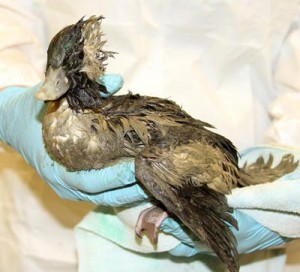
On the afternoon of Friday, January 16, 2015, we received word that there were about 50 Surf Scoters sitting on the beach at East Bay Regional Shoreline on San Francisco Bay. As a diving duck that largely lives entirely on the water except during breeding season, we knew sitting on the beach was extremely unusual behavior for scoters and it was likely the birds were contaminated with something that was affecting their feathers’ waterproofing. Aquatic birds like scoters rely on their normally waterproof plumage to provide buoyancy and insulation against cold water. When the feathers become contaminated, they quickly become cold and exhausted from struggling to swim, and are driven to get out of the water to dry off and rest. Seabirds become emaciated very fast when cold and unable to forage; time is of the essence to rescue them before they starve to death.
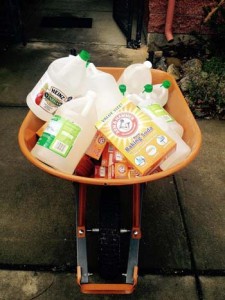
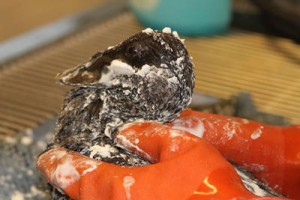
East Bay Regional Parks personnel captured the birds and delivered them to our center for care that Friday evening. When we examined the birds, we found cold, wet birds with a range of feather contamination. Some had a few areas where feathers were stuck together; some had blobs of sticky material that caused the feathers to mat together in a thick mess. Some were stuck to the towels or paper lining from the transport containers.
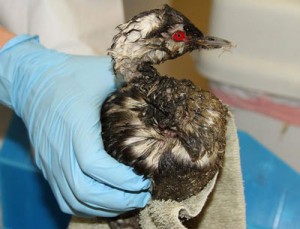
We knew it wasn’t petroleum oil, but it was definitely an environmental contaminant of some kind. It had the texture of a hardened epoxy, slightly tacky to the touch but did not come off on gloves. Thick sections of it showed a translucent gray color. Since we didn’t know what the material was, we weren’t sure we would be able to wash it off the birds. We also didn’t know how hazardous the material was; hence, we erred on the side of caution and required all staff and volunteers working with the contaminated birds to wear the same personal protective gear they would wear during an oil spill.
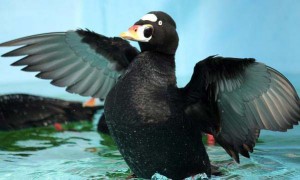
A Rescue Plan Is Hatched
International Bird Rescue’s most experienced bird washers went to work in the wash room Friday night to figure out how to remove the substance, as simple detergent did not cut it. If they were not able to figure this crucial step out, we may have been faced with having to euthanize all the affected birds. It is not possible to pluck feathers and keep species such as scoters out of water for the months needed to regrow a complete set of new feathers, so that was not an option. Thankfully, by late Friday night our staff had worked out a procedure that seemed to do the trick, and they planned to try it on a few birds Saturday morning. The birds were stabilized with warmth, fluids, and food overnight.

On Saturday morning, a dozen birds were washed and progressed through our post-wash waterproofing procedure. Although the birds were more difficult to clean and harder to waterproof after washing than oiled birds usually are, the wash protocol appeared to be working. Each bird took about twice as long to wash as an oiled bird, and several needed to be washed again. Meanwhile, more birds were being found on the beaches. Our wash teams got to work intensively washing birds as fast as possible. By day eight, 313 live birds had been collected and brought to us for care, and one of our wildlife center managers made her goal of 50 birds washed on her 50th birthday.
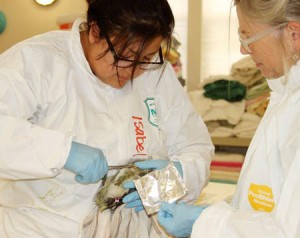
Although I later shifted to medical and surgical management of the numerous injuries of these birds, my role as IBR’s veterinarian at the beginning of this event was to lead the team caring for birds prior to wash. We were very busy examining birds for medical problems and injuries, and providing birds with warmth, fluids and nutrition to strengthen them for the stressful wash process. Surf Scoters are primarily molluskivores, which means they mostly eat mollusks such as clams, mussels, and snails, but may consume any aquatic small prey animals such as worms, crustaceans, or fish roe. In captivity, Surf Scoters readily eat fish and do very well. We typically feed them small fish such as night smelt when they are eating on their own, or tube feed blended fish slurry when they are not. Many of the birds in care were not eating reliably, so were tube fed up to six times a day.
By the third day of the event, I noticed that the most malnourished and emaciated birds were having problems digesting their blended fish. Several birds had begun regurgitating their nutritional tubings and a few had died; it appeared that the food was just sitting in their stomachs decomposing instead of being digested. At that point I decided these birds’ best chance was to feed them Lafeber’s Emeraid Piscivore. Emeraid Piscivore, which is part of Lafeber’s veterinarian-prescribed, species-specific specialty diets, is formulated to have its protein content essentially pre-digested as free amino acids and small peptides, so the animal doesn’t have to put much metabolic work into digestion—it can just directly absorb the nutrients without having to break them down first. This diet is also designed to allow variability in how much fat is added. I contacted Dr. Lafeber, and we arranged for a large shipment of the diet. We had a few days’ supply on hand, so began feeding it to the most emaciated birds right away. We fed it at 11% fat, which was the percent fat I identified as optimal for Common Murres in my Ph.D. work. Once transitioned onto Emeraid Piscivore, the birds stopped regurgitating and began doing much better.
Because we had several hundred birds that needed tube feeding many times a day, we had problems keeping up with making enough blended fish for all the birds. We decided to use the Emeraid Piscivore to round out our food supplies for all birds on tube feedings, not just the most critical cases. Emeraid Piscivore is very easy to make on demand in whatever volume is needed. It has a very fine texture and passes through feeding tubes easily. Of the approximately 6,500 tube feedings these birds received in the first week of care prior to becoming reliable self-feeders, about half the total diet fed was Emeraid Piscivore.
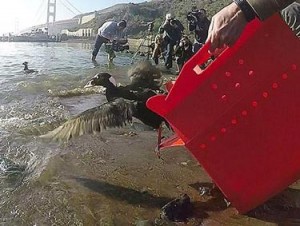
All-in-all, Emeraid Piscivore served us very well in providing an easily-digested diet for the most critically emaciated birds, and helped us through a food supply crisis when we were having problems making less-expensive diet fast enough to feed hundreds of birds simultaneously. It was a great help in managing the care of the several hundred birds affected by this event.





